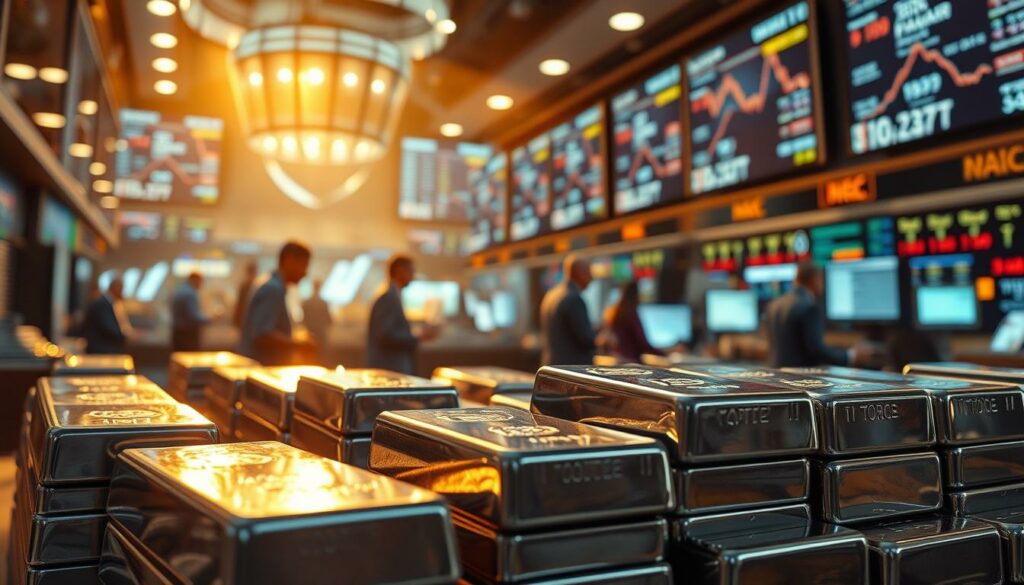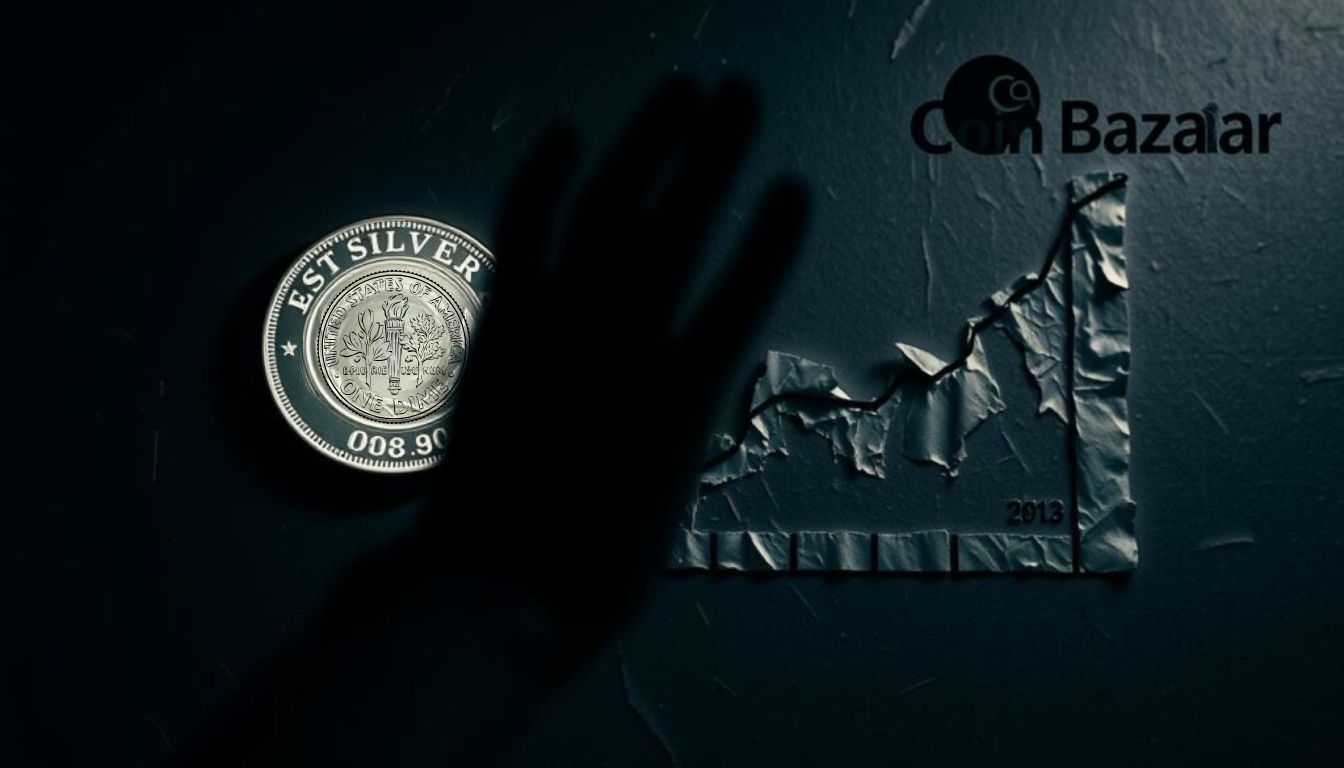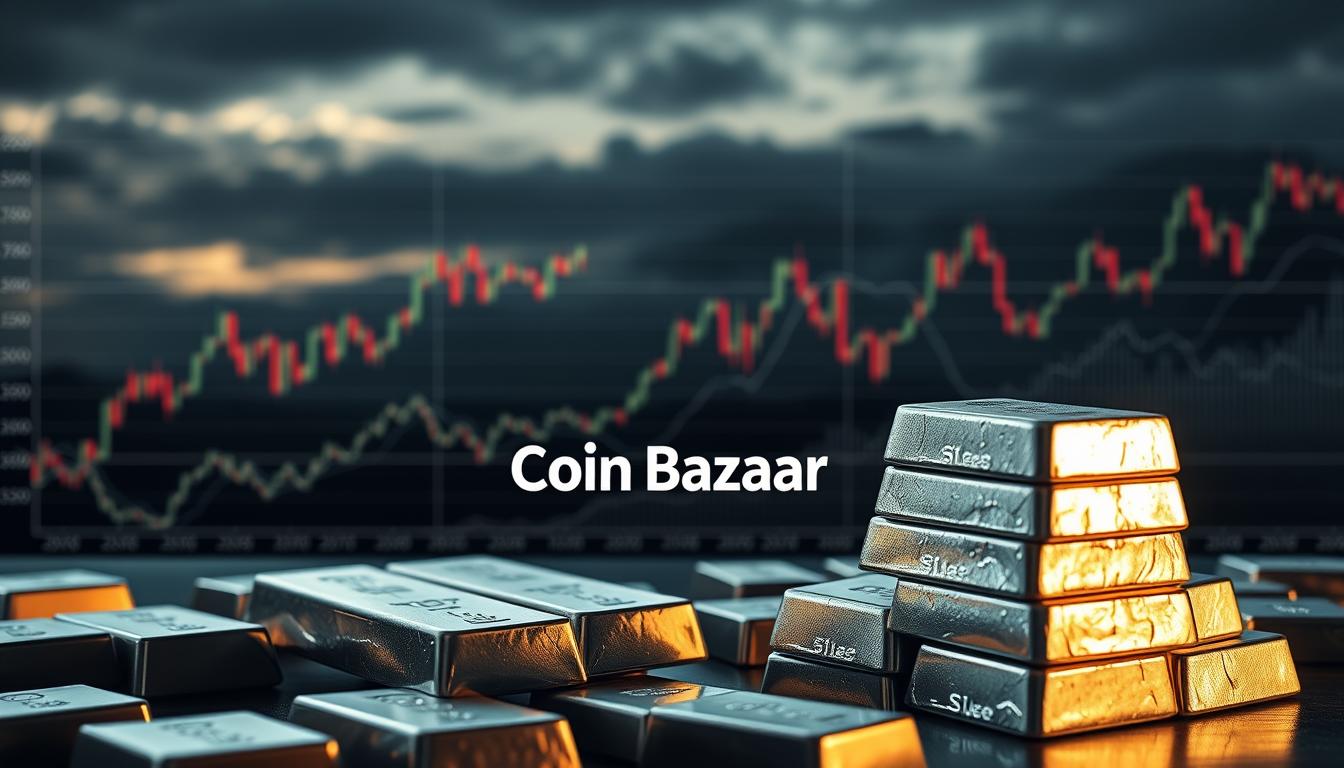Exclusive Deals & Trending Items


Precious Moments Personalised BIS Hallmarked Anniversaery Silver Coin Of 100 Gram in 999 Purity / Fineness By ACPL
Shop Now

Precious Moments Color Brihadisvara Temple BIS Hallmarked Silver Coin Of 20 Gram in 999 Purity / Fineness by ACPL
Shop Now

Modison Lakshmi Ganesh Silver Coin of 20 Grams in 24Kt 999 Purity Fineness in Paper Folder Packing
Shop NowThe silver market is seeing big changes due to shortages. The Silver Institute says the market will be in deficit for the fifth year in 2025.
This shortage is making the price forecast go up. As demand for silver grows faster than supply, prices keep rising. It’s important for investors and fans to know what’s happening in the market.
Key Takeaways
- The silver market is forecast to remain in deficit for the fifth consecutive year.
- Ongoing shortages are driving prices higher.
- The demand for silver continues to outpace its supply.
- Understanding the current market situation is crucial for investors.
- Precious metal trends are influencing the silver price forecast.
The Current State of the Global Silver Market
The global silver demand is expected to stay stable. It’s important to understand the current market dynamics. You will explore the factors that affect the silver market.
Recent Price Movements and Market Trends
Silver prices have gone up due to industrial demand and global uncertainties. The price changes are mainly because of industrial silver consumption, which has increased a lot. This shift is noticed by investors and consumers.
The market trend shows a steady rise in silver prices. This is because of the growing demand from the industrial sector. This trend is expected to keep going, thanks to silver’s expanding use in technology.
Key Statistics on Supply and Demand
The global silver demand is expected to stay the same in 2025 at 1.20 billion ounces. Let’s look at some key statistics:
| Category | 2024 (in billion ounces) | 2025 (in billion ounces) |
|---|---|---|
| Global Silver Demand | 1.18 | 1.20 |
| Industrial Demand | 0.55 | 0.58 |
| Investment Demand | 0.35 | 0.36 |
From the table, we see demand for silver is expected to go up a bit. This is mainly because of industrial demand. Knowing these statistics helps in making smart choices in the silver market.


Understanding the Silver Supply Deficit
The silver market has been in deficit for four years, with 2025 expected to be the fifth. This imbalance affects investors, industries, and the economy. It’s a big deal.
What Constitutes a Market Deficit
A market deficit happens when demand for silver is higher than its supply. This can be due to more industrial use, less mine production, and more investment. The silver supply deficit shows the market’s health. It affects precious metal trends and investment choices.
The demand for silver is high because of its many uses. These include solar panels, electronics, and medicine. But, the supply can’t meet this demand, leading to a deficit.
Historical Context of Silver Shortages
Silver shortages have happened before. Looking at past shortages helps us understand today’s silver supply deficit. Past silver production data shows the current deficit is part of a bigger trend.


The current silver supply deficit is complex. It’s influenced by precious metal trends and silver production data. Knowing these factors helps investors make smart choices in the silver market.
Primary Causes of the Current Silver Supply Deficit
The silver supply deficit today comes from many market forces. It’s key to know the main reasons for this shortage.
The silver mining world is facing big challenges. Declining mine production is a big reason for the deficit.
Declining Mine Production
Silver mine production is struggling due to several issues. Even though production is expected to rise in 2025, it won’t keep up with demand. Mines face problems like lower ore quality and higher costs.
- Lower ore grades mean less silver can be mined.
- Higher costs make some mines not worth running.
- Finding new silver deposits is hard but needed.
Increasing Industrial Demand
Industrial silver consumption is growing fast. This is because of more use in solar panels, electronics, and tech. Silver’s special qualities, like being great at conducting electricity, are why it’s in demand.
As global silver demand grows faster than supply, it’s important to understand this. The demand from industries shows we need to balance supply and demand to fix the deficit.
The Growing Industrial Demand for Silver
Silver’s demand is rising fast, thanks to its special properties and many uses. It’s a great conductor and fights off germs, making it key in many fields.
Solar Panel Manufacturing Requirements
The solar panel industry is a big reason for silver’s growing demand. Silver helps make photovoltaic cells work well because it conducts electricity well. As we move towards green energy, silver’s role in solar panels will only get bigger. In 2025, silver demand is expected to reach a record high, thanks to solar panels.
Electronics and Technology Applications
In the world of electronics, silver is a must-have. It’s used in contacts, switches, and connectors because it conducts electricity better than most. The need for more electronics and smart devices is making silver even more important. The electronics sector’s need for silver shows how vital it is for today’s tech.
Medical and Pharmaceutical Uses
Silver is also important in medicine and pharmacy. Its ability to fight germs is useful in wound care and for coating medical devices. As medical tech gets better, so will the need for silver in these areas.
| Industry | Silver Usage | Growth Driver |
|---|---|---|
| Solar Panel Manufacturing | Photovoltaic cells | Renewable energy demand |
| Electronics | Contacts, switches, connectors | Technological advancements |
| Medical and Pharmaceutical | Wound care, medical device coatings | Healthcare technology advancements |
Silver plays a big part in today’s tech and healthcare. As these areas grow, so will the need for silver. This will keep the silver supply deficit going.
How Investment Demand Contributes to the Silver Shortage
Investment demand for silver is growing fast, making the supply deficit worse. The silver market is greatly affected by investment trends. Recent data shows a big increase in demand.
Physical silver investment is expected to go up by 3% in 2025. This is thanks to better demand in Europe and North America. This increase is a big part of the global silver demand, which is staying strong.
Physical Silver Investment Trends
People are turning to physical silver investment for many reasons. Economic uncertainty and the need for safe assets are key drivers. Silver is seen as a good hedge against inflation and market ups and downs.
- Increased demand from institutional investors
- Rising popularity of silver ETFs
- Growing awareness of silver as a diversification tool
ETFs and Paper Silver Markets
Exchange-Traded Funds (ETFs) and paper silver markets are big in silver investment. These tools let investors get into silver without having to hold the metal physically.
The silver price forecast suggests prices might go up. Investors should think carefully about their choices. ETFs and paper silver markets will keep shaping silver investment demand.
It’s important to understand these trends for smart silver market investments. As global silver demand changes, keeping up with market news is crucial for navigating silver investment.
Challenges Facing the Silver Mining Industry
The silver mining industry is expected to see a 2% increase in production by 2025. Yet, it faces many challenges that could slow its growth. These include high production costs, strict regulations, and environmental concerns.
Production Costs and Profitability Issues
High production costs are a major hurdle for the silver mining industry. As extraction costs rise, it’s hard for mining companies to stay profitable. This is especially true when silver prices can fluctuate a lot.
Here’s a look at some key production cost metrics for major silver mining companies:
| Company | All-in Sustaining Cost (AISC) per Ounce | Average Silver Price for Profitability |
|---|---|---|
| Company A | $15 | $20 |
| Company B | $18 | $22 |
| Company C | $12 | $18 |
Regulatory and Environmental Constraints
The silver mining industry also deals with strict regulations and environmental concerns. Environmental regulations are getting tougher. They require mining companies to use more sustainable practices and cut down their environmental impact.
For example, companies might need to use new technologies or processes to reduce waste and emissions. While these rules help protect the environment, they can also make operations more expensive and complex.
Secondary Supply: Recycling and Scrap Recovery
The global silver market is facing a supply deficit. Recycling and scrap recovery are becoming more important. They help meet the growing demand from various industries.
Current Recycling Rates and Potential
Silver recycling is expected to grow by 5% in 2025. It’s set to reach over 200 Moz for the first time since 2012. This shows a positive trend in secondary supply, easing some pressure on primary production.
The current recycling rates depend on silver prices and recycling technology efficiency.
Challenges in Silver Recovery
Despite the positive outlook, silver recovery faces challenges. Recovering silver from products like electronics and solar panels is complex. There are also environmental concerns with recycling.
Efficient recycling technologies and regulations are key to overcoming these hurdles. They help maximize secondary supply’s potential.
| Year | Silver Recycling Volume (Moz) | Growth Rate (%) |
|---|---|---|
| 2023 | 180 | 3 |
| 2024 | 190 | 5.5 |
| 2025 | 200 | 5 |
In conclusion, recycling and scrap recovery are crucial for meeting global silver demand. Understanding secondary supply’s role is vital for the silver market’s future.
Regional Analysis of Silver Supply and Demand
It’s key to know how silver is made and used around the world. The global silver supply is set to rise by 3% in 2025. This growth comes from more mining in places like China, Canada, and Chile.
Major Producing Countries
A few countries lead in silver production. Mexico, Peru, and China are at the top. They play a big role in the world’s silver supply.
Recent silver production data shows these countries keep their production steady. Some even see a small increase thanks to new mines.
Consumption Patterns Across Regions
Demand for silver varies by region. Asia and North America have a lot of electronics and solar panels. This means they need a lot of silver for these products.
In places like India, silver is in high demand for jewelry and investments. This drives the global silver demand. A close look at the silver market analysis shows how important these differences are.
As the silver market changes, knowing these regional differences is crucial. It helps investors and industry folks make better choices. By studying these trends, you can make smarter investments in silver.
The Indian Silver Market: Demand, Culture, and Investment
Silver is very important in Indian culture, going beyond just decorations. It’s also seen as a good investment and used in rituals. The demand for silver in India is shaped by both old traditions and new investment trends.
Cultural Significance and Traditional Uses
In India, silver is more than just a valuable metal. It’s deeply rooted in culture and religion. People often wear silver jewelry and use silver items during big events like festivals and weddings. This is because silver is valued for its beauty and worth.
Indian Silver Jewelry and Bullion Market
The market for silver jewelry in India is big, with many seeing it as a safe investment. The bullion market also plays a key role, with people buying silver coins and bars to invest.
However, the demand for silver jewelry in India is expected to drop by 6% in 2025. This is because of high local prices. This shows how the Indian silver market is affected by global price changes.
Impact of Global Deficit on Indian Consumers
The global silver deficit affects Indian buyers, especially in terms of price. As the world’s supply gets tighter, prices are likely to go up. This will impact both the demand for jewelry and investment choices.
| Year | Silver Demand in India (Tonnes) | Global Silver Price (USD/Oz) |
|---|---|---|
| 2023 | 10,000 | 20 |
| 2024 | 9,500 | 22 |
| 2025 | 8,900 | 24 |
As the global silver deficit grows, Indian buyers will face higher prices. This could change how much silver people want to buy. It’s important for both investors and buyers to understand these changes.
Price Mechanisms in a Silver Supply Deficit Market
Understanding price mechanisms is key when there’s a silver supply deficit. It helps you make smart investment choices. Knowing how prices are set in a market with more demand than supply is crucial.
The silver market, like others, is shaped by supply and demand. But the current deficit brings unique challenges to price setting. Price discovery is how we figure out an asset’s price based on supply and demand.
Price Discovery in Physical vs. Paper Markets
Price discovery works differently in physical and paper markets. Physical markets deal with real silver, like bullion or coins. Paper markets handle financial items like futures contracts and ETFs.
The interaction between these markets affects prices. For example, a rise in demand for physical silver can push prices up. This can then influence the value of paper silver investments.
| Market Type | Characteristics | Impact on Price |
|---|---|---|
| Physical Market | Involves actual silver trading | Directly affects price through supply and demand |
| Paper Market | Involves financial instruments like ETFs and futures | Influences price through speculative trading |
Historical Price Responses to Supply Shortages
Supply shortages in the silver market have often led to price hikes. Looking at past supply deficits can show this.
For instance, when industrial demand is high and supply is low, silver prices go up. The ongoing supply deficit is expected to keep prices rising. Silver prices might even outpace gold, with a 23% gain in 2025 forecasted.
The Gold-Silver Ratio: What It Means for Your Investments
The gold-silver ratio is key for investors looking to make the most of market trends. It shows how many ounces of silver it takes to buy one ounce of gold. This ratio is crucial for making smart investment choices.
Recently, the gold-to-silver ratio hit 90 in January 2025 and then started to fall. This change shows how fast the precious metals market can move. It’s important to keep an eye on the ratio to make good investment decisions.
Historical Ratio Analysis
The gold-silver ratio has changed a lot over time. It’s influenced by things like supply and demand, the economy, and what investors think. Looking at past trends can help predict what might happen next.
- The ratio is often seen as a sign that silver might be cheaper than gold when it’s high.
- But when the ratio is low, it might mean silver is too expensive compared to gold.
Using the Ratio for Investment Timing
Investors use the gold-silver ratio to decide when to buy silver. If the ratio is high, it might be a good time to invest in silver. This is because the ratio often goes back to its average, which could make silver more valuable.
Key considerations include:
- Keep an eye on the ratio’s historical averages to spot any big changes.
- Understand what’s causing the ratio to move.
- Use the ratio along with other market signs for a solid investment plan.
Silver Investment Opportunities You Should Consider
The silver supply deficit is not going away, making it key to look into different investment options. The demand for silver is growing, thanks to its use in industries, as an investment, and in new technologies.
Investors have many ways to benefit from silver market trends. Physical silver is a favorite, with a 3% increase forecasted for 2025. This growth is mainly due to higher demand in Europe and North America.
Physical Silver Options for Indian Investors
Indian investors can buy physical silver through bullion dealers, online sites, and banks. It’s important to buy hallmarked silver from trusted sources.
Mining Stocks and ETFs Available in India
Investing in mining stocks and ETFs is another smart move. Many Indian brokerages offer silver ETFs that mirror silver prices. You can also invest in mining stocks of companies that produce silver.
Risk Management Strategies for Silver Investments
To handle risks in silver investments, spread your investments across different types of assets. Use stop-loss orders and hedging strategies to reduce losses. Always do your homework and talk to financial advisors before investing.
Experts say the silver market will stay strong because of the ongoing supply deficit and rising demand. Market analysts agree, seeing silver as a promising investment.
Government Policies Affecting the Silver Market
Government actions can change the silver market’s balance. It’s key to know these policies for smart choices.
The silver market is shaped by many government policies. These can be direct rules on silver trade or broader money policies that affect the market.
Indian Government Regulations on Silver
In India, silver is influenced by import duties and taxes. These can change silver’s price and demand. For example, higher duties can make silver pricier for Indians, affecting demand.
The Indian government aims to reduce imports and boost local production. This can greatly impact the global silver market.
Rules on hallmarking and jewelry making also shape silver demand in India. India is a big consumer of silver jewelry.
Global Monetary Policies and Their Impact
Global money policies, like interest rates and quantitative easing, deeply affect the silver market. For instance, loose money policies can make silver more appealing as a hedge against inflation. This is because silver’s value goes up when currencies fall.
Also, money policies in big countries can change the world economy. This can boost silver demand from industries. So, it’s vital to watch global money policy changes and their market effects.
Future Outlook: Will the Silver Deficit Continue?
Experts predict the global silver deficit will last until 2025. This shortage is caused by rising industrial demand and limited mine production. The solar panel and electronics sectors are driving this increase.
Short-term Market Projections
The silver market will face ongoing pressure due to the supply deficit. The silver price is expected to be volatile. This is because of both physical demand and investment trends.
Important factors to watch include:
- Continued growth in solar panel manufacturing and other industrial applications
- Potential disruptions in mine production due to regulatory or operational challenges
- Investment demand for physical silver and silver ETFs
Long-term Supply and Demand Forecasts
The long-term outlook for silver demand is positive. This is due to new technologies and the shift to renewable energy. However, the supply side faces challenges like declining ore grades and rising production costs.
Industry experts say, “the silver market is likely to remain in deficit for the foreseeable future. This is because of the growing demand from the renewable energy sector.”
“The silver market is likely to remain in deficit for the foreseeable future, driven by the growing demand from the renewable energy sector.”
The global silver demand is expected to keep growing. This growth is driven by both industrial uses and investment demand. As the world moves towards cleaner energy and technologies needing silver, the silver price forecast suggests a higher price in the long term.
Technological Innovations Driving Future Silver Demand
Technology keeps getting better, and so does the need for silver. It’s because silver is key in new tech. You’ll see more silver used in many fields because of its special qualities.
Emerging Technologies Requiring Silver
Solar energy is a big user of silver. It’s great for making solar panels work well. As we move to clean energy, silver demand will go up.
In electronics and technology, silver is used in many parts. This includes things like connectors and switches. With more gadgets and tech, silver use will increase.
Silver is also good for medical and healthcare because it fights germs. It’s used in bandages and medical tools. As health tech gets better, so will silver’s use in medicine.
Potential Substitutes and Their Limitations
There are other materials that could replace silver in some cases. But, they might not work as well. For example, copper is being looked at for solar panels, but it’s not as good as silver.
In electronics, other materials can stand in for silver. But they might not be as good or cost-effective. Knowing this helps you make smart choices about investing in silver.
Conclusion: Navigating the Silver Market Amid Ongoing Deficits
The silver market faces challenges due to ongoing deficits. Mine production is falling, industrial demand is rising, and investment interest is growing. To succeed, you must understand what affects silver prices and industry trends.
Investment opportunities in silver can guide your choices. Watching precious metal trends and the gold-silver ratio can help you invest wisely. The Indian market, with its cultural importance and increasing demand, offers special chances.
When looking at investment options, stay updated on government policies, new technologies, and market forecasts. This knowledge will help you navigate the silver market’s challenges and seize opportunities.

















